What are Mass Extinctions?
- The natural disasters we have discussed so far have killed individuals
of one or more species. They are not considered events that triggered an extinction.
- Extinction: so many individuals die that reproduction fails
- Mass Extinction: all members of one or more species die suddenly or within a relatively short time. Also, a mass extinction that involves many species can be triggered by removal of just one member in the food chain (e.g. large-bodied herbivores).
Today, more than 99% of all species that have ever existed are extinct.
Why Does Earth have Life - Astronomy
- Earth's distance to Sun allows it to maintain an atmosphere and bearable temperatures
- Earth's closeness to Sun allows Earth to receive enough sunlight for bearable temperature and water to exist in liquid form
- Moon is a relatively large satellite that contributes to relatively stable orbital parameters for Earth
- changes to Earth's orbital parameters are relatively small, causing relatively mild climate changes (see Milankovitch cycles in Lecture 21)
- comparison with Mars:
- Mars' distance from Sun is 1.52 AU (astronomical units; average Earth-Sun distance)
- Earth's eccentricity is 1-5%, Mars' is 9.3%
- Earth's obliquity (tilt of spin axis) changes between 21.5 and 24.5°: Mars' is currently 25.2° but varies immensely over time
- Mars' atmosphere: major constituent: CO2; no greenhouse because atmosphere is thin
- comparison with Venus:
- Venus' distance from Sun is 0.72 AU
- Venus' current eccentricity is 0.7%, so not anomalous
- Venus' obliquity is 177.4° so Venus' revolution around Sun is retrograde (spin and orbital revolution have opposite sense); practically no seasons
- Venus' length of day is 243 Earth days; Venus' orbital period is 225 Earth days; a Venus "year" is therefore longer than a Venus "day"
- Venus' atmosphere: major constituent: CO2; extremely dense causing extreme atmospheric pressure at surface (92 times Earth's); extreme greenhouse causing surface temperatures around 450°C (surface rocks glow red)
Why Does Earth have Life - Biochemistry
- after the initial cooling, early Earth had traces of CH4, NH3, H2 and - above all - H2O
- lab experiments show that exposing such a mixture to lightning caused condensation to organic compounds (made of C, N, H)
- addition of water is the next step to make amino acids and other building blocks of life
- polymerization leads to macromolecules such as proteins, nucleic acids, polysaccharides
- three additional conditions: 1) supply of self-reproducing molecules; 2) copying of these molecules must be subject to errors (mutations); 3) perpetual supply of free energy and partial isolation from general environment (membranes)
- ..... eventually formation of DNA (protein, hereditary molecule) from "proto" RNA (nucleic acid)
Classification of Life
- In a somewhat outdated but simple scheme, different life forms on Earth are classified like a family tree. Life on Earth has 5 (or 6) kingdoms which then branch out into subcategories (phyla, classes, orders, families, genera and species).
- kindom: animals, plants, fungi, protista (eukaryotes), monera (prokaryotes)
Monera are sometimes sub-divided into two kingdoms: Eubacteria (true bacteria) and Archaeobacteria or Archea (ancient bacteria). - phylum: e.g. the animal kingdom branches out into vertebrates (chordata) and invertebrates
- class: e.g. the vertebrate phyllum branches out into: mammals, fish, dinosaurs (that includes birds in a sub-class), amphibians and reptiles
Examples:
The word protista comes from the Greek word "protos" for first. Protista include all simple unicellular and multicellular forms.
For example, tracing the lineage of today's humans through the tree of life: kingdom: animals; phyllum: vertebrates; class: mammals; order: primates; family: hominids; genus: homo; species: homo sapiens.
Some Basic Life Forms
- The distinction between prokaryotes and eukaryotes comes from the fact whether a cell has a nucleus or not (from Greek word "karyon" for nut).
- Prokaryotes: from Greek "pro" for before; have no nucleus; basically all bacteria
(kingdom: monera); DNA as strands in cytoplasm; two main sub-categories that are sometimes divided into two different kingdoms:
- Archaeobacteria: can live in extreme environments, e.g. within the Earth several km down, hot, anaerobic environment such as active vents near mid-ocean ridges. In fact, O2 kills archea and their life is based on S instead. The processes involved to collect and use energy are relatively inefficient.
- Eubacteria: some eubacteria are capable of doing photosynthesis, e.g. cyanobacteria, or "green-blue algae" (this name is actually misleading as cyanobacteria are bacteria and not algae)
- Eukaryotes:cell has a nucleus in which DNA is stored; kingdom protista and higher; various organelles distributed through the cell that perform different functions; e.g. chloroplast (photosynthesis); mitochondria (power source)
- viruses: not included in the traditional classification of life. Viruses are basically simple strands of DNA sheathed in proteins; they can't live independently and often need a host to reproduce. In contrast to bacteria, can't be cultured in artificial media. Many viruses are inactivated by heat. High mutation rate (eg. polio virus mutates 2% during its three-day passage through the human intestinal system; humans took 8 Mio yrs for the same level of mutation). Bacteria produce a new generation within 20min, viruses accomplish this is less time.
- prions: not included in the traditional classification of life. Examples include the agent causing BSE (bovine songiform encephalopathy or mad cow disease). Proteins folded in an abnormal way. No traditional reproduction. Turn other proteins into prions upon contact. Evoke no immune response in infected bodies. Resist heat, UV, radiation, sterilization.
Time Line of Early Life
- About 3/4 of Earth's existence saw only "simple life". It is only the last 600Mio years
or so, that we have complex multi-cellular life forms, i.e. life as we know it.
- 3.5 billion yrs ago: appearance of Archaeobacteria
- shortly thereafter: appearance of Eubacteria (some doing photosynthesis)
- 1.1 billion yrs ago: simple Eukaryotes; single-celled organisms with a nucleus
Approximate timeline of early life forms:
Photosynthesis and Respiration
- Photosynthesis: uses sunlight, CO2 and H2O to produce sugars/cellulose and O2
- Chemisynthesis: uses, H2S instead of H2O to produce S instead of O2; slower metabolism and less efficient than photosynthesis
- Respiration: uses enzymes and O2 to break down sugars to storable energy in phosphate bonds; CO2 and H2O as by-products; in regard to oxygen, this process is a "reversed photosynthesis" though respiration typically does not require as much O2 as is produced during photosynthesis
- Fermentation: low-efficiency equivalent to respiration; no O2 required; produces alcohols in intermediate step
Oxygen sources and Sinks in the Atmosphere
| Oxygen Producers and Users | |
|---|---|
| Process | Production (+)/Usage (-); kg/yr |
| photochemistry | + 10 8 |
| weathering of rock | - 10 11 |
| volcanism | - 10 4 |
| photosynthesis | + 10 14 |
| respiration/decay | - 10 14 |
| burial of carbon from organisms | + 10 11 |
| recycling of buried sediments | - 10 11 |
| fossil fuel combustion | - 10 12 |
- Photochemistry is the process in the atmosphere when H2O molecules are broken down after absorbing UV radiation. H2 escapes into space.
- Carbon in decaying organisms uses oxygen from the atmosphere so oxygen is "gained" when burying these organisms.
- The recycling (bringing back to surface) of sediments is in balance with the burial.
- Respiration is now in balance with photosynthesis but was less in early geologic times.
- The atmosphere has currently 6x1017kg oxygen. If photosynthesis was shut off, weathering and volcanism would destroy the oxygen in only 6 Mio years.
- photosynthesis is the most significant process to increase oxygen in the atmosphere
Atmospheric Oxygen over Time
| Approximate Timeline | |
|---|---|
| Time before Present | Amount of Oxygen |
| 3.5 - 2 billion years | prob. less than 1% |
| 2 - 1.5 billion years | significant increase (prob. up to 5%) |
| Eukaryotes (that require aerobic environment) | |
| formation of ozone layer | |
| 1.5 billion years | oxygen level near 5% |
| 0.6-0.4 billion years | tremendous increase in oxygen level (> 30%) |
| 0.3 billion years | oxygen level nears today's level (> 80%) |
How do we know? For some evidence, see Appendix B.
Evolution of Life and the Geologic Time Scale
| Rough Geologic Timescale | ||||
|---|---|---|---|---|
| Time Span | Eon | Era | Period | Major Appearance |
| (Mio yrs | ||||
| before present) | ||||
| 2.6 - 0 | Quaternary | Humans (1.0) | ||
| 65 - 2.6 | Cenozoic | Tertiary | Human ancestors (3.5) | |
| 142 - 65 | ^ | Cretaceous | ||
| 206 - 142 | | | Jurassic | birds | |
| 251 - 206 | Mesozoic | Triassic | dinosaurs and mammals | |
| 290 - 251 | Permian | |||
| 354 - 290 | Carboniferous | Reptiles (325) | ||
| 417 - 354 | ^ | ^ | Devonian | Amphibians |
| 443 - 417 | | | | | Ordovician | Land Plants |
| 495 - 443 | | | | | Silurian | |
| 544 - 495 | Phanerozoic | Paleozoic | Cambrian | vertebrates; Fishes |
| 2500 - 544 | Proterozoic | sexual reproduction (1000) | ||
| 4000 - 2500 | Precambrian | Archean | oldest fossil (3600); olderst rock (4000) | |
| 4570 - 4500 | Hadean | |||
- If the evolution of life on Earth were projected onto 1 hour, then life with no or very little oxygen would take up almost 30 min. Oxygen-based life under a protecting ozone layer was possible only within the last 20 min. Multicellular marine life started roughly 660 Mio years ago, just before the Cambrian, with invertebrate creatures that left little traces. This translates to the last 8.5 min. Life as we know it, with creatures that have hard parts, did not start until the Cambrian, 550 Mio years ago, the last 7.5 min. During this time many species evolved and died either as being part of the background extinction or a mass extinction. Dinosaurs that reigned from the Triassic through the Cretaceous would live in the last 3min20s, only to die after 2.5min. The last 52 seconds correspond to the Cenozoic, the Tertiary and Quaternary, that began 65 Mio years ago.
And ancestors of humans appeared within the last 3 seconds, or so, 3.5 Mio years ago. Homo sapiens has been around for the last 1.5 Mio yrs, or 1.3s.
- 3 major faunas have dominated animal life: Cambrian, Paleozoic, Modern
- only Cambrian explosion brought forth new lineages, while the other two only enhanced the number of species
- size and complexity of organisms have increased
- predators have become more efficient
- human-induced extinctions used to affect only large animals but now reach into microscopic scales
Basics on Evolution
- changes to species through adaptation/survival of the fittest
- natural selection is not a random process
- changes to gene pool may be random but this is a rare process
- need large enough gene pool for survival (e.g. to preserve traits in the species)
- evolution may be a long process (e.g. the evolution of the land-living mesonychid to the basilosaurus, the ancestor of our whales, took from 55 Mio yrs ago to 42 Mio yrs ago)
The Cambrian Explosion of Life
- Starting at about 550 Mio years ago, a 40 Mio year long burst of evolutionary changes. Nature experimented with species that could survive. Many died out after a short while but others survived. Animals start to have hard parts (vertebrates) and so are better preserved. This tremendously simplifies paleontologists' jobs to trace live in the past. Examples of species that appeared (as were shown in class) include the snale-like Lapworthellid, the miniature-limpet like Mobergella and the Trilobite came in all sizes, from 1mm to 72cm (1/25 - 28").
Life in the Carboniferous through the Cretaceous Periods
- (times in Mio years before present)
- Carboniferous (354 - 290): relatively cold; large glaciers on Gondwanaland; swamps in tropics (tree ferns, horsetail); worldwide coal deposits; first tetrapods; reptiles; examples shown in class include a plant cast of horsetail and a dragon fly whose wing span was 60cm (24in)! Dragon flies are predators!
- Permian (290 - 251): Pangaea; further cooling; sea level drop; more reptiles than amphibians; lineage for mammals from reptiles; bony fish
- Triassic (251 - 206): frogs, turtles, dinosaurs; conifers, seed ferns; examples shown in class include the Pterodactyl (flying lizard) and the Kuehneosaurus whose wing span was 60cm (24in); his little cousin, the Draco Volans still lives in Southeast Asia;
- Jurassic (206-142): bony fish; salamanders; lizards; flying reptiles; bipedal predatory and quadrupedal herbivores dinosaurs; mammals; examples shown in class include the Ammonite, a sea creature that left us beautiful curly fossils; the stegosaur (a plant-eating dinosaur with spiky plates on the back) and a mosquito preserved in amber (fossil tree sap). This gave the author of Jurassic Park (Michael Crichton) the idea that dinosaurs could be "revived" by placing the DNA from dinosaur blood preserved in the mosquito in the amber in frog cells (or was it chicken??). IS this scientifically plausible? Check out recommended reading below!
An interesting "relict" from the Jurassic is the Coelacanth, a fish living in the Indian ocean and thought extinct until it was discovered by a fisherman in 1939. - Cretaceous (142 - 65): high sea level; marine invertebrates diversified; snakes; flowering plants; many small mammals; some of the largest dinosaurs including the supersaur (30m/100 ft high) and the seismosaur (36m/120ft high); the predatory Tyrannosaurus Rex lived in the late Cretaceous
Possible Causes for Mass Extinction - Before Humans
-
GEOLOGICAL PROCESSES
- climate changes (warming as well as cooling though more extinctions appear to be related to warming)
- bolides/large impacts: global cooling (aerosols block sunlight), fire, tsunami, earthquakes
- flood basalt volcanism: changes atmospheric chemistry -> global cooling (SO2) or warming (CO2)
- sea level changes: both drop and increase has impact on shallow coral reefs and seas
- sea floor spreading: changes sea level as well as output of volcanic gases -> climate, ocean chemistry
- plate tectonics: geometry (size and location) of continents influences ocean currents/climate
- change in ocean processes/ocean chemistry; e.g. acidification leads to collapse of corals/shell forming species; lack of deep ocean mixing/loss in oxygen in deep ocean
- release of methane/gas hydrates -> accelerated warming
- interruption of food chain
- new predator or competitor
- new disease
- habitat loss
SPECIES RELATED PROCESSES
The Five Major Mass Extinctions and Why They Happened
The discussion of whether an impact or volcanic activity triggered mass extinction is still ongoing. Evidence for either of these comes from the sudden appearance of Iridium, an extremely rare element. Iridium on the Earth's surface comes either from meteorite impacts or from deep inside the Earth through the extensive volcanism of large igneous provinces/flood basalts.
-
A nice summary of the five mass extinctions was given in the "Quest" section of the San Diego Union Tribune on November 12, 2003 (show me!). A similar summary can be found in the biology textbook "Life"(2).
- Ordovician: marine life with more than 600 different families was not destined to last;
possible causes: pronounced global cooling and decrease in precipitation(5); significant drop in sea level (by as much as 1000ft/330m, according to Atlas referred to below); transition into an ice age; shallow seas on continental shelves turned into dry plains - Devonian:"age of the fishes" accelerated evolution; featured abundance of diverse aquatic life forms; tree ferns; first forest soil;
possible causes: reason for extinction not clear; long period when many species died; some impacts; lowering in sea level by 300ft; destruction of shallow seas by collision of continents - Permian: the period when Pangaea formed; cool climate; most serious mass extinction; 90% of all species died out (63% tetrapods, 33% amphibians, 60% marine life including trilobites marine diversity reduced from 250,000 species to just 10,000);
possible causes: sea level dropped, laying bare most coral reefs - all-time low in last 545 Mio yrs and below today's sea level-; weather warming at the end of Permian though precipitation decreased (Figure 10.25); possible bolide impact; large flood basalts in Siberia (largest in the world); new evidence suggests massive belching of methane bubbles from deep ocean floor causing global warming - Triassic:
possible causes: not clear; no obvious impact crater found so far; Iridium find points toward volcanic cause; drop in sea level; slight cooling but probably not enough for a mass extinction - Cretaceous:
the mass extinction at the K-T boundary (K from German Kreide for chalk) marks the demise of the dinosaurs; mammals survived and took over; the cause for the mass extinction is the most hotly debated; Iridium finds and the recently imaged impact crater at Chicxulub point toward death by impact; but the massive Deccan Trap flood basalts in India also formed at this time, suggesting that death came by a combination of factors; sea level dropped sharply just before and temperature and precipitation increase after the proposed time of the impact
The Ice Age and More Recent Extinctions
- Recent extinctions are likely caused by human interaction (see Lecture 23). Many species did not survive the last ice age. These include
- woolly mammoths
- mastodons (related to elephant)
- wooly rhinos
- giant ground sloths (lived in South America)
- musk oxen
- saber-toothed tigers
- cave lions
- cave bears
- giant deer
- steppe bison
- wild horses
- scrats (rat-like creatures)
NB: the "wild" mustang in North America was "reintroduced" by the Spaniards.
- Though there may be natural components as well, humans had a major role in the reduction of mammoths. In Eurasia, mammoths were hunted down to build huts (about 80 mammoths provided bones for just one hut). Recent studies suggest that climate changes (and associated changes in the food source) also had an impact.
- Flightless Birds: Many victims of recent extinctions include flightless birds. Humans either hunted them for food, pleasure or fashion statements or introduced predators such as cats and mongooses (a big problem in Hawaii right now!). Large birds have disappeared from Madagascar (elephant bird; 3.4m high; weighing 500kg) and New Zealand (moa; 4m high), while smaller cousins still survive in Africa (ostrich), Australia (emu) and South America (rhea).
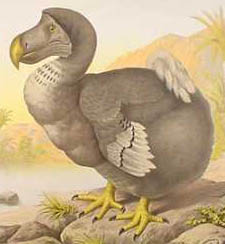 Source: wikipedia |
the DODO on Mauritius: A particularly sad example was the DODO a flightless bird on Mauritius in the Indian Ocean. The DODO stood up to two feet high. In the animated movie "Ice Age" we can watch the last female jumping over the cliffs (thereby terminating reproduction) but the bird died out much later. It was discovered on Mauritius in 1598 by sailors and was extinct within less than 100 years (1681) by overhunting and the introduction of predators. |
Possible Causes for Mass Extinction - Human Induced
- climate changes
- overhunting/overharvesting
- interruption of food chain
- introduction of predator or competitor (e.g. cats, rats, rabbits)
- introduction of disease/pest/poison
- habitat destruction
Ongoing Extinctions
- The extinction of species has recently accelerated and it is estimated that if the extinction rate of the last 200 years continues for the next 200 years, we will face the greatest mass extinction the Earth has ever seen.
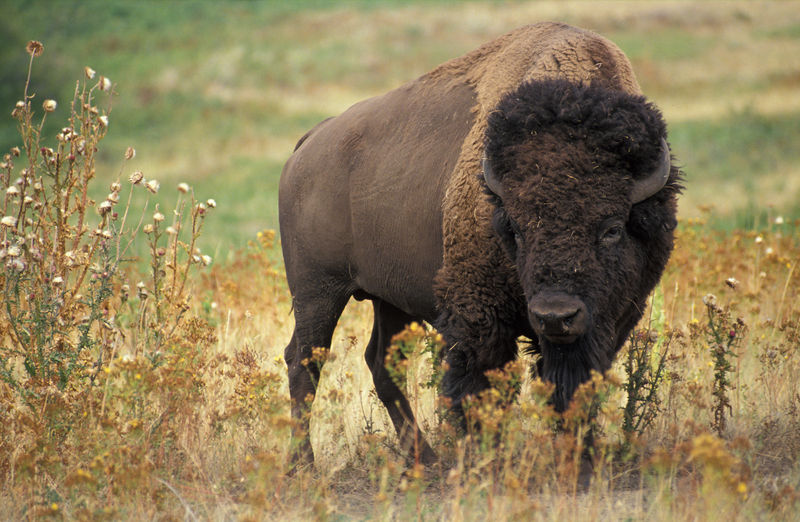 Source: wikipedia |
Buffalo (extinct in the wild; conservation dependent): A recent example in North America is the American Buffalo (bison bison). At one point an estimated 50 Mio buffaloes roamed through the prairies. By 1875, they were virtually extinct in the wild. There are now two places, the Yellowstone National Park and Wood Buffalo, CN where buffaloes can run free, in a protected area. |
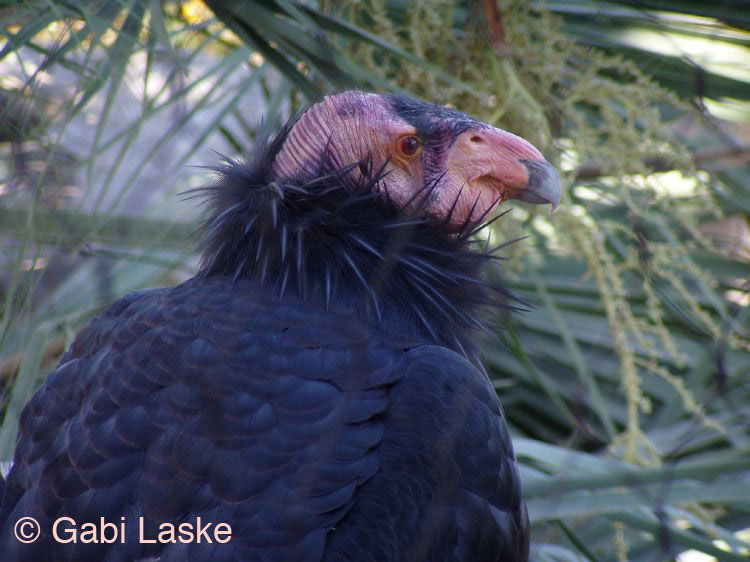 Photo: Gabi Laske |
California Condor (critically endangered): this mighty bird was decimated by the early 1900s through hunting, habitat loss and lead poisoning; by 1987, the condor was extinct in the wild, with 27 individuals captured; captive breeding programs (such as that of the San Diego Wild Animal Park) and reintroduction are problematic as there are only few places left that are adequate as habits; one of these is the Grand Canyon; recently, 40 individuals were returned to the wild where some died. Threats to released condors are manifold. At least one was electrocuted when flying into power lines. One got shot. Some dead condors were found with lead bullets in their stomach that they ingested with dead animals. Most likely they died from lead poisoning. A new California law prohibits using lead ammunition in Condor land. Some of the 2008 fires in California burned through important condor habitat and at least two condors and a rearing station fell victim to the fires. The Wild Animal Park lost its condor station in the Guejito fire in 2007 but no condor was killed and the station has been replaced. |
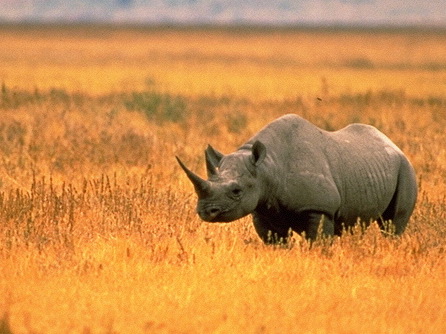 Source: wikipedia |
Black Rhino (critically endangered): its ancestors roamed the planet for the last 50 Mio yrs; in the early 1900s there were several 100,000 in Africa; by 1960, there were still more than 100,000; by 1995, there were just 2410; the rhinos were decimated through poaching in the 70s/80s for their horn; poaching is still going on though the remaining rhinos are heavily protected; the problem here is not (only) the poachers but also the market that provides the demand for the horn; the western black rhino has 10 individuals left and has been declared extinct (see Gambler's Ruin); the northern white rhino is also declared extinct, with 4 individuals left; the number of species is now down to 5 (from 30) |
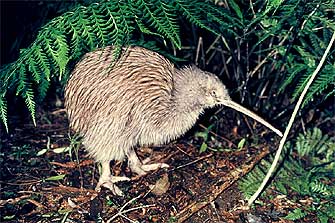 Source: New Zealand Department of Conservation |
Kiwi (vulnerable): New Zealand's State Bird (endangered): a flightless bird that has a 40-year life-span; the only bird whit nostrils (sniffs for worms) and burrows; nocturnal; very vulnerable to predators (95% of the chicks are killed by cats); 1000 yrs ago there were 12 Mio kiwis; by 1923, this number was down to 5 Mio; 70,000 were left by the 1990s; according to a BBC report, the bird has already vanished on the North Island and is predicted to be extinct by 2010. |
Gambler's Ruin
The availability of only few individuals of a species provides a very limited gene pool (see APPENDIX D) and makes re-introduction efforts problematic. Small environmental changes can spell extinction, if the animal "lost" the trait of survival to that specific change that it once might have had in the originally larger gene pool. It is therefore better for a species, if a bottleneck population (reduced population that allows the loss of some traits) is avoided.
Some recent examples of successfully re-introduced or recovered animals after the DDT crisis (e.g. California Brown Pelican) seem to disprove this. The question is if "Gambler's Ruin" also applies to life as the evolution of life is not a random process!
The re-introduction process of the California Condor is still ongoing and the possible outcome is not yet clear.
Recommended Literature
- (1)"Atlas of the Prehistoric World" by Douglas Palmer, 1999, Discovery Books, ISBN: 1-56331-829-6; some pictures shown in class come from this references
- (2)"Life: The Science of Biology" by Purves, Sadava, Orians and Heller, 2001, Freeman & Co., ISBN: 0-7167-3873-2; some comments on evolution and life come from this comprehensive college textbook
- (3)"The Science of Jurassic Park and the Lost World" by Rob DeSalle and David Lindley, 1998, Harper Perennial, ISBN: 0-465-07279-4; can dinosaurs be "revived" from Mosquitoes preserved in amber?
- (4)"Secret Agents: the menace of emerging infections" by Madeline Drexler, 2003, Penguin Books, ISBN: 0-1420.0261-5; interesting read on bacteria, viruses and prions
- (5)"Natural Disasters" by Patrick Abbott, MacGraw Hill